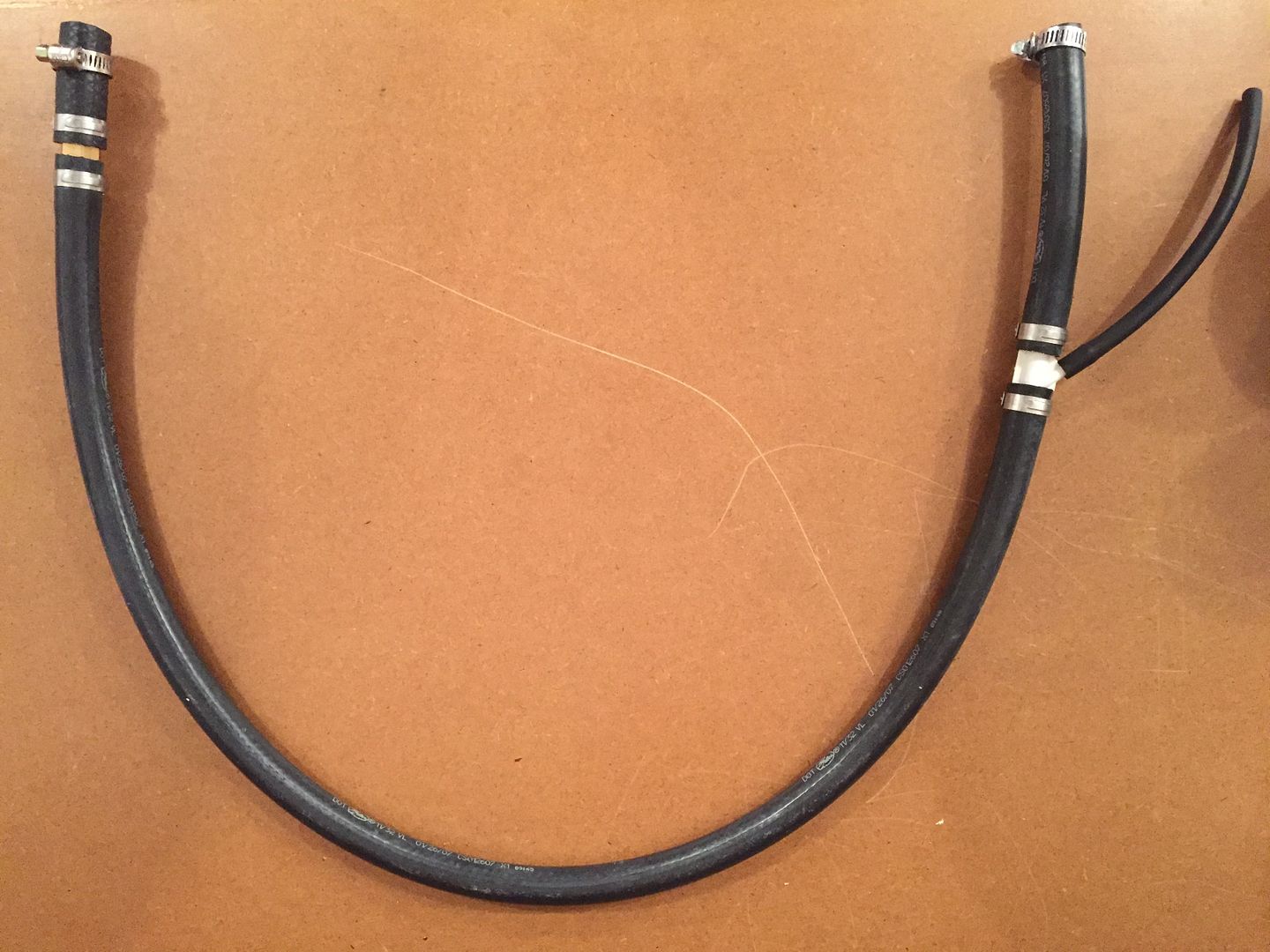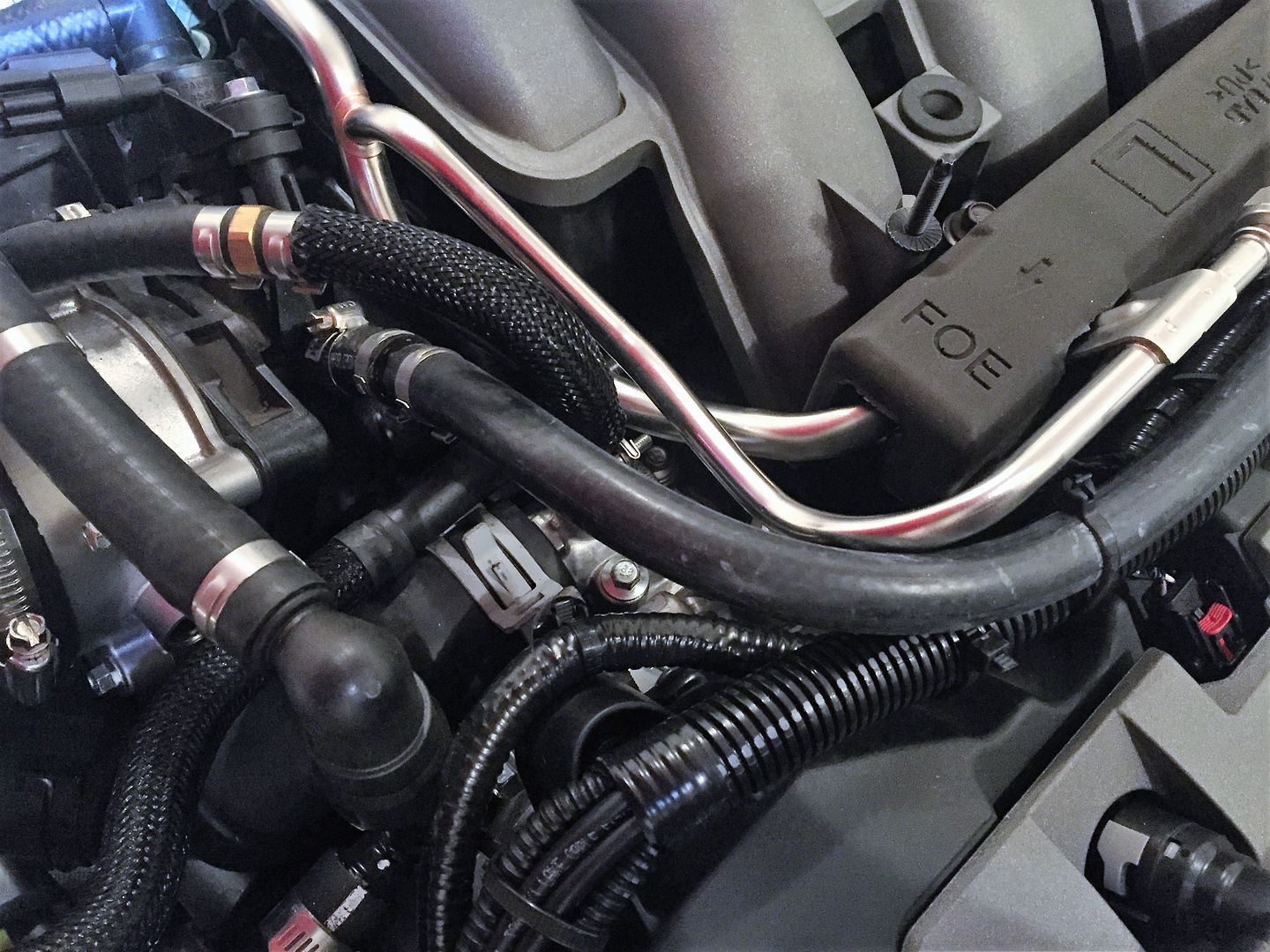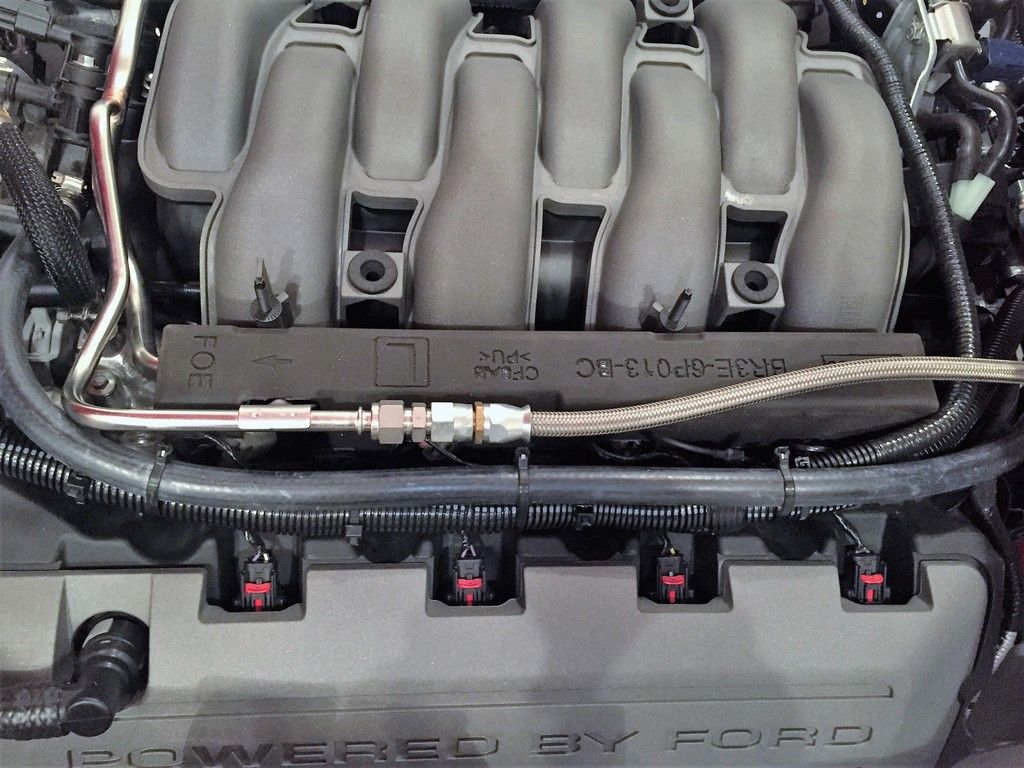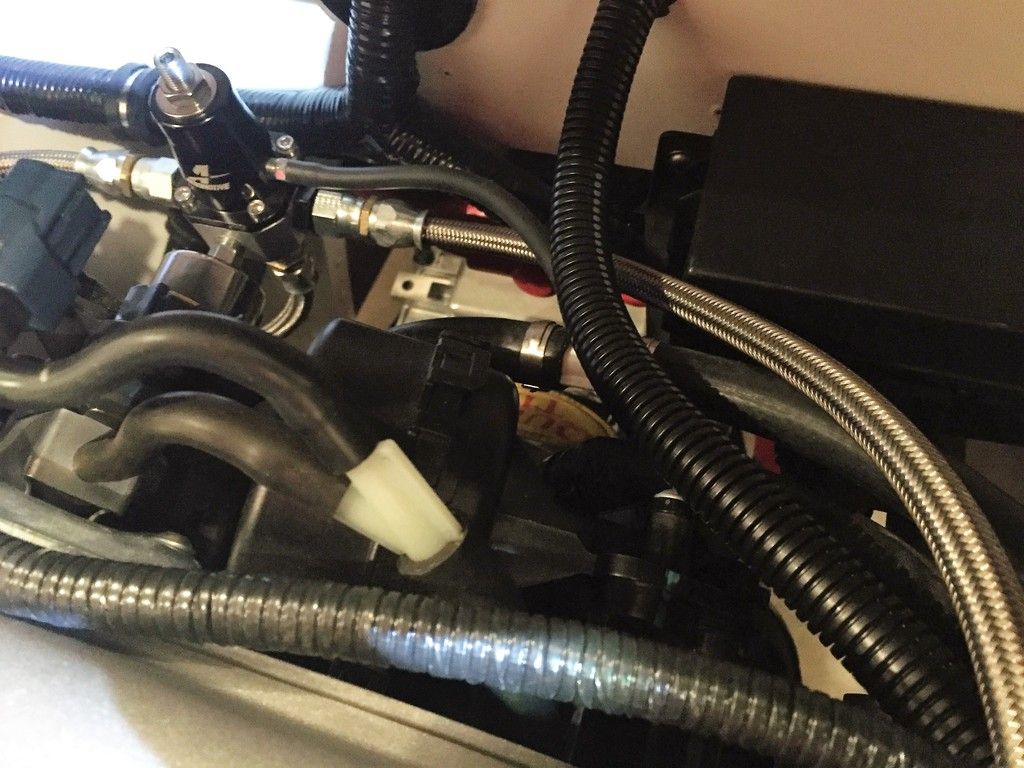When I ordered the base Coyote crate motor (M-6007-M50A) last October for my Anniversary Roadster #8674 build, I found that Ford had released an updated version. There were many changes to the engine itself as well as a completely new crate motor Controls Pack. One of those was the addition of Charge Motion Control Valves (CMCV) also called intake manifold runner controls. The manifold runners are driven by vacuum motors on the back of the intake controlled by the PCM, and are supposed to provide better idle and higher torque at low RPM’s. The CMCV function is cited as one of the reasons for the higher torque ratings of the updated Coyote.
Neither the Factory Five Coyote installation manual or the Ford Performance M-6017-504V 5.0L Controls Pack instruction sheet mention anything about the CMCV function. Several of us, myself included, took the same plumbing and installation approach. But after running/driving are getting P2004 (Intake Manifold Runner Control Stuck Open Bank 1) and P2005 (Intake Manifold Runner Control Stuck Open Bank 2) DTC’s. This post addresses the overall issue. This won’t be short. So get comfortable for a bit of a read.
There are at least four ways this can be approached. Each has pluses and minuses.
(1) Custom tune with the P2004 and P2005 error codes suppressed. The manifold runner default positions are open and one can argue the benefits they provide are not important for our build.
(2) Remove the vacuum motors completely and lock down the runners. There are aftermarket parts available. Also requires tune changes. For some builds, like the 33, there isn’t space available for the vacuum motors.
(3) Change to the Boss intake which removes the stock intake and CMCV function completely. Custom tune (again) but that’s necessary with the Boss intake anyway. I don’t think there’s any question the Boss intake looks better. But the performance improvement, especially for the 2015-2016 Coyote, is questionable especially for how we run the cars. Plus it’s not a cheap solution.
(4) Leave everything intact and plumb the CMCV system to do what it’s designed to do. That’s what I thought I was doing with my initial plumbing, but turns out that’s not the case. The balance of this post will focus on this aspect and what I believe is a solution for this choice.
Out of the box, the crate motor has two vacuum lines going through the intake. One on each side. The one on the left (DS on this side of the pond) goes from the CMCV vacuum motors to a connection on the cold air intake. The one on the right (PS) goes from a large connector on the back of the intake into space at the front of the motor. Several of us dug a little deeper and found this connection makes its way over to the power brakes booster in a Mustang, so deemed it unnecessary and removed it.
For my initial installation, I installed a connector on the Spectre intake for the vacuum line on the DS. I used the large connection vacated by the PS hose as the vacuum source for the fuel regulator. There is another large vacuum connection on the front of the engine near the throttle body. Factory Five shows using this as the vacuum source for the fuel regulator. I thought it was easier and neater to use the closer one on the back of the intake. With the engine plumbed this way, it started and ran just fine. Several short go-karts seemed great. I did get one occurrence of the P2004 and P2005 error codes. But cleared them and they didn’t show up again, so didn’t pursue it. I know of several builds that installed their Coyote just like I described.
Later, several forum members reported the large vacuum connection we were using on the back of the intake for the fuel regulator had no vacuum signal. I measured mine and found this to be the case. Nothing. This certainly seemed a mystery as initial understanding was this provided vacuum for the Mustang power brakes. Various theories included the hole needed to be drilled out, etc. But I just capped it and moved the fuel regulator vacuum to the front connection described by Factory Five. Confirmed it had a strong vacuum signal and considered the installation complete.
Fast forward several months. I have been in contact with Scott (forum member wareaglescott) with a similar 2015-2016 Coyote build. He has been driving his go-kart quite a bit more than me, and has seen the P2004 and P2005 Intake Manifold Runner Control Stuck Open error codes repeatedly. He started a discussion with Ford Performance tech support and they sent the following Coyote vacuum diagram.
Kudos to wareaglescott for his persistence trying to get to the bottom of this. Studying this diagram is very enlightening. Multiple observations:
(1) The large connection on the rear of the intake with the hose on the PS of the engine, that we have all removed, is part of the vacuum circuit for the CMCV system, but not in the way we expected.
(2) There is a reservoir in the rear of the intake pressurized by the line we removed. First I’ve heard anything about a vacuum reservoir in the intake.
(3) The CMCV circuit actually receives it’s vacuum from another connection on the rear of the engine (which we haven’t disturbed) on the reservoir. So that part is OK. But since the reservoir isn’t being pressurized, there’s no vacuum available for the CMCV circuit.
(4) The hose we removed actually attaches to yet another hose that we didn’t receive with the engine (the one at the top of the diagram) and it attaches to the vacuum connector Factory Five told us to use for the fuel regulator vacuum signal. That’s where both the power brakes and CMCV circuit get their vacuum. Sounds confusing but it really isn’t.
Armed with this new information, I decided to re-plumb my installation. The PS vacuum line that was previously removed could perhaps be re-used, but too late. I pitched it along with other unused parts. It would be a bit awkward anyway IMO. Instead I made up a new hose going from the large vacuum port on the front of the engine by the throttle body around to the nipple on the back of the intake. At the back, I put in a “Y” connector with a smaller hose for the fuel regulator. It was a little challenging because all the connectors are different sizes. This is the bill of material for what I came up with:
2 inches long 1/2-inch ID fuel hose
30 inches long 11/32-inch vacuum hose
5-1/4 inches long 11/32-inch vacuum hose
6 inches long 5/32-inch vacuum hose (this length could vary based on fuel regulator location)
3/8-inch barb / 1/4-inch NPT male fitting (Xtra Seal 15-5744)
3/8 x 3/8 x 3/16 “Y” fitting (included in Dorman 47354)
Hose clamps as required
The 1/2-inch ID fuel hose is the only thing I could find that fit the vacuum fitting on the front of the engine. Normally it’s not recommended to use fuel hose for vacuum because it’s made for pressure not vacuum. But for this short of a piece, it’s not going to collapse and should be fine. The 11/32-inch vacuum hose fits the nipple on the back of the intake. The only thing I could find to make the transition between the two was the barb/NPT fitting. Not completely desirable, but the NPT threads fit tightly into the 1/2-inch hose and with a clamp I think will be fine. I found all the parts listed at my local O’Reilly Auto Parts store. The final assembly looked like this:
I used pinch clamps in several places because they’re neat, look OEM, and I have a selection on hand along with the pincers to install them. Regular worm drive clamps could be used for all instead. I didn't put any clamps on the small hose from the "Y" connector to the fuel regulator. The barbs are both pretty long and the smaller hose seems a tight fit. I don't think they're going anywhere. The hose assembly installs on the DS of the engine and easily fits under the engine cover. Here are a few pics of it installed.
I tie wrapped it to the wiring cable added previously, just to keep it in place under the cover. Last night I started the engine and ran it for a bit with the new plumbing. I don’t know if it’s my imagination or not, but it seemed to run even better than before. No sign of any DTC’s, but they only seem to show up in actual driving. But I’m confident the CMCV system is now receiving the same vacuum as the factory setup. Hopefully this information is helpful for other 2015-16 Coyote builders.
- Home
- Latest Posts!
- Forums
- Blogs
- Vendors
- Forms
-
Links

- Welcomes and Introductions
- Roadster
- Type 65 Coupe
- 33 Hot Rod
- GTM Supercar
- 818
- Challenge Series
- 289 USRCC
- Coyote R&D
- Ask a Factory Five Tech
- Tech Updates
- General Discussions
- Off Topic Discussions
- Eastern Region
- Central Region
- Mountain Region
- Pacific Region
- Canadian Discussions
- Want to buy
- For Sale
- Pay it forward
-
Gallery

- Wiki-Build-Tech



 Thanks:
Thanks:  Likes:
Likes: 







 Reply With Quote
Reply With Quote






 The GT350 intake and TB is another option for sure. But the $1300 price of admission will keep me with my kluged $20 vacuum hose for now.
The GT350 intake and TB is another option for sure. But the $1300 price of admission will keep me with my kluged $20 vacuum hose for now.








 ). Sounds like your 2017 version is correct. DS no hose. The CMCV vacuum motors are vented to atmosphere, so no hose to the intake like previous versions. On the PS, you should have the hose connected to the vacuum port on the front by the throttle body. Like the diagram Ducky2009 posted.
). Sounds like your 2017 version is correct. DS no hose. The CMCV vacuum motors are vented to atmosphere, so no hose to the intake like previous versions. On the PS, you should have the hose connected to the vacuum port on the front by the throttle body. Like the diagram Ducky2009 posted.

